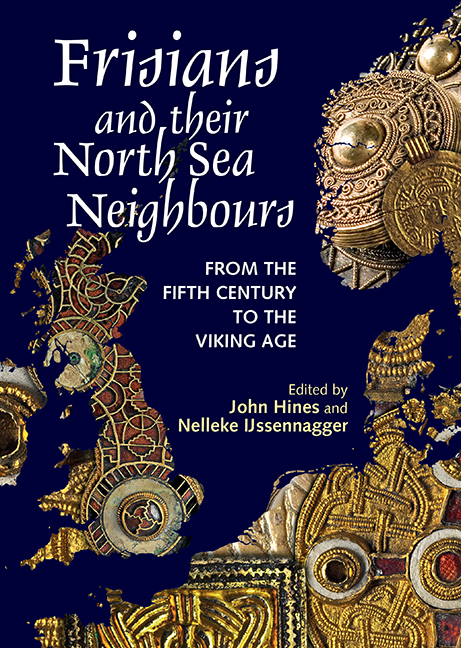Book contents
- Frontmatter
- Contents
- List of Figures
- List of Tables
- Preface
- Acknowledgements
- Linguistic Conventions and Abbreviations
- Abstracts
- Introduction: Frisians – Who, When, Where, Why?
- 1 Palaeogeography and People: Historical Frisians in an archaeological light
- 2 The Anglo-Frisian Question
- 3 Frisian between the Roman and the Early Medieval Periods: Language contact, Celts and Romans
- 4 ‘All quiet on the Western Front?’ The Western Netherlands and the ‘North Sea Culture’ in the Migration Period
- 5 Power and Identity in the Southern North Sea Area: The Migration and Merovingian Periods
- 6 How ‘English’ is the Early Frisian Runic Corpus? The evidence of sounds and forms
- 7 The Geography and Dialects of Old Saxon: River-basin communication networks and the distributional patterns of North Sea Germanic features in Old Saxon
- 8 Between Sievern and Gudendorf: Enclosed sites in the north-western Elbe–Weser triangle and their significance in respect of society, communication and migration during the Roman Iron Age and Migration Period
- 9 Cultural Convergence in a Maritime Context: Language and material culture as parallel phenomena in the early-medieval southern North Sea region
- 10 The Kingdom of East Anglia, Frisia and Continental Connections, c. ad 600–900
- 11 A Comparison of the Injury Tariffs in the Early Kentish and the Frisian Law Codes
- 12 Cultural Contacts between the Western Baltic, the North Sea Region and Scandinavia: Attributing runic finds to runic traditions and corpora of the Early Viking Age
- Index
3 - Frisian between the Roman and the Early Medieval Periods: Language contact, Celts and Romans
Published online by Cambridge University Press: 25 August 2018
- Frontmatter
- Contents
- List of Figures
- List of Tables
- Preface
- Acknowledgements
- Linguistic Conventions and Abbreviations
- Abstracts
- Introduction: Frisians – Who, When, Where, Why?
- 1 Palaeogeography and People: Historical Frisians in an archaeological light
- 2 The Anglo-Frisian Question
- 3 Frisian between the Roman and the Early Medieval Periods: Language contact, Celts and Romans
- 4 ‘All quiet on the Western Front?’ The Western Netherlands and the ‘North Sea Culture’ in the Migration Period
- 5 Power and Identity in the Southern North Sea Area: The Migration and Merovingian Periods
- 6 How ‘English’ is the Early Frisian Runic Corpus? The evidence of sounds and forms
- 7 The Geography and Dialects of Old Saxon: River-basin communication networks and the distributional patterns of North Sea Germanic features in Old Saxon
- 8 Between Sievern and Gudendorf: Enclosed sites in the north-western Elbe–Weser triangle and their significance in respect of society, communication and migration during the Roman Iron Age and Migration Period
- 9 Cultural Convergence in a Maritime Context: Language and material culture as parallel phenomena in the early-medieval southern North Sea region
- 10 The Kingdom of East Anglia, Frisia and Continental Connections, c. ad 600–900
- 11 A Comparison of the Injury Tariffs in the Early Kentish and the Frisian Law Codes
- 12 Cultural Contacts between the Western Baltic, the North Sea Region and Scandinavia: Attributing runic finds to runic traditions and corpora of the Early Viking Age
- Index
Summary
Language and history
Languages expand and contract over time and space. For obvious reasons, this phenomenon attracts linguists, who study language change and its mechanisms. What is less familiar is that this study, apart from its contribution to purely linguistic matters, can yield information which is relevant to historians and archaeologists. This article deals with one type of information: demographic history. More specifically, this contribution centres around the fact that languages spread in two ways:
1. As a result of the propagation of the genes of their speakers – that is, by the multiplication of children speaking the language of their parents and migrating into a new area. If in a previously inhabited area a language primarily spreads in this way, speakers of that language join and often replace speakers of a previously existing language. The result is demographic discontinuity. An example is the expansion of European languages, particularly English, in North America at the expense of Native American languages.
2. As a result of the acculturation of people who previously spoke another language. In this case, it may require only a small number of speakers migrating into a new area in order for the natives to adopt that language and, ultimately, often to abandon their native language. The result of this type of language expansion is demographic continuity. An example is the expansion of French in modern-day Brittany at the expense of Breton.
Normally, the expansion of a language is a blend of both mechanisms, one outweighing the other as a matter of degree. In the case of the expansion of European languages at the expense of Native American languages, demographic replacement strongly outweighed acculturation (cf. Padel 2007, 228–9). In the case of French and Breton, the situation is the reverse (cf. Ternes 2011, 436–9).
The expansion of Latin in the Western Roman Empire is a well-known example of a language that spread primarily as a result of acculturation, although it should be added that it went hand in hand with a minor expansion of people from central Italy. In this particular case, Latin was so successful that it replaced almost all other native languages on Western Roman territory.
- Type
- Chapter
- Information
- Frisians and their North Sea NeighboursFrom the Fifth Century to the Viking Age, pp. 43 - 52Publisher: Boydell & BrewerPrint publication year: 2017

